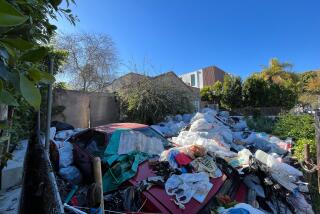Blighted homes linger in L.A., frustrating neighbors
Jim and Lynda Horan had no idea whom to call when the people who had moved into the foreclosed home next door started trashing the place.
They tried U.S. Bank, which property records indicate owned the house on a quiet, dead-end street in Sunland. They tried city code enforcement. They tried the police.
But the junk piles in the yard kept growing. Strangers kept coming at all hours. The neighbors started stealing water from other neighbors and running generators.
“We went on vacation for two weeks in November and spent the whole time wondering if our house was all right, wondering if they were going to set fire to the place,” said Lynda Horan, who believes the neighbors were illegally squatting. “That’s a terrible way to live.”
Although the mortgage crisis may be over, thousands of foreclosed houses still linger across Los Angeles, and they’re still frustrating neighbors and dragging down neighborhoods despite city programs designed to prevent that.
Los Angeles’ 4-year-old foreclosure registry requires banks to pay a fee and list a local property manager for every house they own in the city. The list included 4,300 properties in May. They are in every corner of the city, from Sylmar to San Pedro, Bel-Air to Boyle Heights. But they are concentrated in the same neighborhoods that suffered most during the housing crash: South L.A., the Eastside and parts of the San Fernando Valley.
And they continue to be problematic properties. Houses on the foreclosure registry are nearly twice as likely as the average home to have had at least one code enforcement complaint since the start of 2013, according to a Times analysis of city building and safety records.
Police and fire services, cleanup and code enforcement on nearly 200,000 foreclosures cost Los Angeles nearly $1.2 billion, or about $6,000 per house, over four years, according to a 2011 study by the California Reinvestment Coalition and Alliance of Californians for Community Empowerment.
The registry was designed to help lower that bill. But its effectiveness has lately come under increased scrutiny at City Hall.
An audit issued last week by City Controller Ron Galperin criticized the program on several fronts and pointed out that the city does no third-party verification of foreclosures. That suggests the city may have many more than the 4,300 foreclosed homes in the registry, he said. Legislation introduced Tuesday by Councilman Gil Cedillo would streamline the registry process and, as a way to finance city inspections, levy an extra fee when homes are taken over by banks.
“Our ordinance was inherently flawed,” he said.
Los Angeles was one of hundreds of cities to create such a registry during the foreclosure crisis. The L.A. ordinance requires annual online registration of every foreclosure and the phone number for a local property manager.
Trouble is, the city’s Division of Building and Safety says it has no money to inspect the properties; city officials have approved six dedicated foreclosure inspectors but haven’t yet found the money to hire them, spokesman Luke Zamperini said. When Building and Safety does respond to a complaint, he said, it treats foreclosures no differently from any other building and tracks down the house’s owner through property records.
“We don’t have the records,” Zamperini said. “We do contact the bank. In many cases, they can actually do something.”
In his audit last week, Galperin recommended a better system for referring blighted foreclosures to building inspectors and an online registry that could be easily shared among city agencies. The beginnings of such a system already exist. Last week, as part of its new open data project, DataLA, the city put its foreclosure registry online, with phone numbers for banks and property managers.
That kind of info could help identify some troubled properties, Zamperini said, though complaints from neighbors tend to be the most effective way.
That’s what the Horans tried, logging nine complaints with Building and Safety over nearly two years. The house next door was on the foreclosure registry for much of that time. But the number listed for U.S. Bank in Minnesota rings to a fax machine, and the one for a local property manager rings with no answer.
Although Los Angeles County property records say U.S. Bank has owned the house since March 2012, bank spokeswoman Teri Charest said it gained access to the house only this spring. The previous owner, she said, had leased the house shortly before it was foreclosed upon, and it took a lengthy eviction process to get the tenants out and the place cleaned up.
Today the house is locked and empty, with an eviction notice and the phone number of a property management firm taped inside the window.
If the city’s building division and U.S. Bank were working to clear the house all that time, the Horans say they never heard about it. They credit the city attorney’s office with finally forcing a resolution.
Either way, they’re glad the long ordeal is over, and they’re still keeping a close eye on the place. Jim Horan photographed the license plate of an unfamiliar car parked outside it last week. Lynda Horan was on the phone to code enforcement asking for some broken wood along the fence line to be removed.
The Horans are being vigilant because the house is still empty. It’s not on the market yet, and after the beating it has taken, the place might be tough to sell. Meanwhile, Lynda Horan said, they’d rather not have a repeat of the last two years.
“I don’t need any more people moving in there,” she said.
Twitter: @bytimlogan
Times staff writer Sandra Poindexter contributed to this report.








